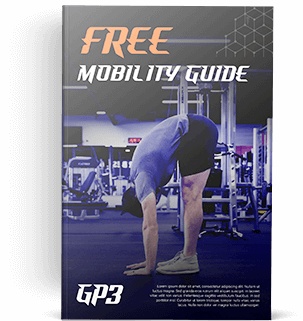Key Points:
1. A “hard set” is defined as “taken to or near technical failure/form breakdown.”
2. Ten hard sets is the maximum any muscle group can handle in one day.
3. There is no weekly limit to hard sets, but anything over 20 is probably more than you need.
Estimated reading time 5-10 mins
Are you training hard enough?
The concept of “hard sets” was thoroughly researched and popularized by Brad Schoenfeld, Ph.D., one of the most prolific researchers in the fitness world. Understanding “hard sets” allows us to take a massive step forward in the way we train our bodies.
Perhaps you’re familiar with the concept of “rep ranges.” For quite a while, it was taken as fact (and even required knowledge in my NSCA certification exam!) that the number of reps you performed in a set was inextricably linked to the adaptations your body would make.
Maybe you’ve seen something like this:
- 1-5 reps
- Pure strength gains
- 6-7 reps
- Some strength gains, some hypertrophy (muscle size gains)
- 8-12 reps
- Pure hypertrophy
- 13-14 reps
- Some hypertrophy, some endurance gains
- 15+ reps
- Pure endurance gains
FOR THOSE WHO SKIM & SCROLL… THE ABOVE SECTION IS NOT ACCURATE, BUT USED TO BE FITNESS GOSPEL!
While this looks nice and neat and clean, the problem is, we now know it’s not accurate.
It turns out, doing sets of 20+ reps still leads to strength and hypertrophy gains. Also, sets of 1-3 reps can still induce hypertrophy, if the weight is heavy enough and your technique is solid.
What matters most is that a set is “hard.”
What does this mean? Well, let’s work backwards a bit. A set taken to failure is certainly “hard.” However, you don’t need to take your sets to absolute failure for it to count as “hard.”
This is where the concept of short and long range training comes into play. If you haven’t read this article, I highly recommend it! But then again, I’m biased, since I wrote it.
If you don’t feel like reading it right now, here’s what you need to know.
- Short range training means challenging a muscle in its shortest and most contracted position. This type of training is beneficial for:
- Blood flow and warmup
- Developing neural control, sometimes called the mind-muscle connection
- Quickening recovery between training sessions
Examples include:
- Triceps kickbacks
- Leg extensions
- Machine hamstring curls
- Long range training means challenging a muscle in its longest and most extended position. When an athlete is ready, this type of advanced training is beneficial for:
- Strengthening connective tissue like tendons and fascia, not just muscles
- Preventing injury
- Increasing athleticism
Examples include:
- Skullcrushers
- Deep squats
- Nordic hamstring curls
For short range sets, true, absolute failure is very rare. “Technical failure” or form breakdown, is much more common, but even that isn’t necessary. With a short range set, as long as you get to the point where it feels like the target muscle is cramping, burning, and fatiguing, you’ve likely done enough for it to count. Not having to go to absolute failure is good news, because you can usually grind your way through 5-10 extra reps in a short range set on pure willpower alone. Now, I don’t recommend that you do this, as it’s not necessary for hypertrophy and the risks of injury and excess fatigue aren’t worth it, but it does serve as a useful contrast to long range.
Long range exercises make it a little easier to judge what constitutes a hard set, because if you’ve chosen a sufficiently challenging weight, your target muscles will become thoroughly, utterly fatigued at some point between 5 and 15 reps. If you’ve ever tried to do exercises like Nordic Hamstring Curls, heavy skullcrushers, or true Ass to Grass squats, you know the feeling of not being able to perform another rep if your life depended on it.
Again, you don’t have to reach this point. Even stopping a few reps shy of this is sufficient. It’s simply helpful to know.
So…what counts as “hard?”
Let’s use the bench press to illustrate.
When performed correctly, a full range, neutral grip bench press can be a great medium-to-long range chest exercise. So, let’s say that your absolute max on this exercise is 8 reps with 80 pound dumbbells in each hand. If you perform 5 or 6 reps with 80’s, 7 or 8 reps with 70’s, or 12 to 15 reps with 60’s, all of those should be sufficient to count as “hard sets.” They’re all going to push you close to failure and fatigue.
Knowing what we do about short & long range training, here’s the recommended best practice:
- Short range exercises: 20-50 reps
- Long range exercises: 5-15 reps
As long as you pick a weight that is sufficiently challenging in those ranges, you’re golden. To clarify, “sufficiently challenging” means that you could not have done enough reps with good form to go well outside of that range. But even then, there’s some wiggle room. If you went to complete failure at 17 reps with a long range exercise, that would definitely still count as a “hard set.” Similarly, if you went to complete form breakdown/technical failure at 17 reps of a short range exercise, that would still count as a hard set.
Now, if you only performed 5 reps and you could have done 15, it would not count as a hard set. Or, if you did 15 reps with a weight that’s less than 50% of your theoretical max on that exercise, it also wouldn’t count.
However, at the end of the day, you don’t need to stress about this. If a set felt hard, it probably was. If you are moving the bar, dumbbell, or machine much slower by the end of the set than you were at the beginning, it probably counts as a hard set. Simply keep performing reps until you notice that your form is no longer good, or ideally, until it feels like your form is just a rep or two away from breaking down. That’s all you need to do.
So, here’s the key takeaway:
If you want a muscle group to grow, prioritize hard sets. But…how many hard sets do you need?
Great question! I’m glad you asked. There are two things to keep in mind here.
Schoenfeld’s team was unable to find an upper limit for hard sets per week. This means they did not find a point of diminishing returns on a weekly basis, and they tested up to 35-40 sets per week! Let me be clear. That is a metric **** tonne of sets. You likely do not need to do nearly that many sets to reach your goals. I’m going to get more into this shortly, but for now, just start with 10 or 15 hard sets per week per muscle group you want to grow.
Also, keep this in mind, because it’s incredibly important. There is an upper limit to the effective number of hard sets per day. They found this number to be a nice, round ten sets. I can’t stress the following point enough:
Once you’ve done 10 hard sets with a muscle group, any sets beyond that are functionally useless.
Consider these extra sets “junk volume,” because they won’t give you any additional strength or size benefits. In fact, they’re just fatiguing you further, increasing your risk of injury, and increasing the length of your recovery time. This is highly important when designing your program, because it will help you avoid a classic mistake especially common in younger lifters.
In their enthusiasm for their new hobby, they’ll say things like this, “Okay, it’s chest, shoulders, and triceps day, so here’s what I’m going to do…”
- Bench barbell press: 4 sets of 8 reps
- Incline dumbbell bench: 4×12
- Decline dumbbell bench: 4×10
- Close grip bench press: 3×10
- Shoulder press: 3×8
- Skullcrushers: 3×12
- Kickbacks: 3×10
- Chest flies: 3×15
- Pushups: 3xFailure
AGAIN, FOR MY SCROLLERS, DO NOT DO THE ABOVE WORKOUT. IT’S AN EXAMPLE OF WHAT NOT TO DO
Here’s another important concept to understand. If a muscle is a primary mover, or heavily involved in a movement, it counts toward the hard sets total.
This is actually a relief when you understand it, because it saves you time in the gym. For example, this essentially means that if you do any kind of pressing movements, you don’t need to do any specific anterior deltoid work. They’re completely covered by the pressing movements. With this in mind, let’s look at the above workout for a moment.
- Chest: 21 sets as prime movers
- Anterior Delts: 21 sets as prime movers
- Triceps: 6 sets as prime movers, and a whopping 27 total sets in which they’re involved
This means that in this sample program, our hypothetical lifter did over double the amount of work their chest, shoulders, and triceps could sustain in a single session. If that is the case:
1. They probably weren’t using enough weight for all of these sets to be considered “hard.”
2. They’re doing this an absolute maximum of one time per week or are using steroids.
3. They’re going to hurt themselves or already did.
So, if you take one thing away from this article, let it be this, so that you don’t hurt yourself or waste your time. Nobody wants that!
Ten is the maximum number of hard sets you can do per muscle group in a single day.
- Triceps: 6 sets as prime movers, and a whopping 27 total sets in which they’re involved
This means that in this sample program, our hypothetical lifter did over double the amount of work their chest, shoulders, and triceps could sustain in a single session. If that is the case:
1. They probably weren’t using enough weight for all of these sets to be considered “hard.”
2. They’re doing this an absolute maximum of one time per week or are using steroids.
3. They’re going to hurt themselves or already did.
So, if you take one thing away from this article, let it be this, so that you don’t hurt yourself or waste your time. Nobody wants that!
Ten is the maximum number of hard sets you can do per muscle group in a single day.
If 10 is the maximum number you can do in a session, and understanding that you need at least 36 hours to fully recover between sessions, you’re realistically limited to 3 or 4 sessions per week for a particular muscle group.
This would come out to 30-40 hard sets per week. Again, this is likely far, far more sets than you need. If you have a stubborn muscle group that won’t grow, I promise you that it will grow with 15-20 sets per week. This is especially true if you’re warming up with multiple short range sets to continue honing your neurological connection with this muscle. And yes! These short range “warmup” sets still count towards your total.
So, if you want a muscle group to grow, here’s your plan.
Twice a week, simply perform 6-10 sets where your desired muscle group is the main mover. Split the sets evenly between short and long range movements. On top of that, prioritize sufficient sleep, hydration, and protein intake. Repeat for 12-16+ weeks, grab a mirror, get your flex on, then sit back and enjoy the results.
Before you go, I’d love to hear from you. Have you heard of the concept of “hard sets” before? Were you one of those people who used to do 12 different pec exercises on chest day? What else do you want to know about hard sets? Let me know!

